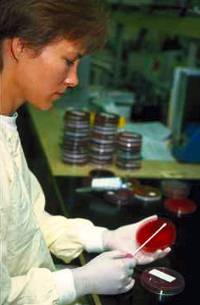31 August 1999
Unemployed Rodents Picket Research Labs
by Kate Melville
 Perhaps we will never see thousands of tiny mice picketing university research labs on TV, but it's a sight that this jaded old writer would pay to see!
Perhaps we will never see thousands of tiny mice picketing university research labs on TV, but it's a sight that this jaded old writer would pay to see!
It won't ever happen, but the days of lab mice may be numbered thanks to Japanese Medaka - a tiny freshwater fish. At the UGA, toxicologists have transferred genes from bacteria into Medaka to help evaluate the genetic health risks of chemicals in the environment.
According to Richard Winn, an environmental toxicologist in the Warnell School of Forest Resources the fish have three distinct advantages: 1 "Transgenic fish offer nearly every kind of exposure route as mice, and, in tests, they can be exposed at low-dose, realistic levels' 2 Fish cost just "pennies a year," compared to around 20 cents per day for a lab mouse. 3 Mice are "less sensitive, politically, than mammals for use in biomedical research."
Transgenic fish carry specific DNA sequences that serve as targets for DNA damage or mutations. Researchers expose the fish to a contaminant and then analyse tissues for mutations in the indicator bacteria. The Medaka can be used for screening organic materials such as PCBs, radiation, heavy metals, herbicides and pesticides.
According to Winn, "It's the 'canary in the coal mine' approach to screening that applies to humans. We would never release the modified fish into the wild. In the lab, they act as surrogates for wild fish populations."
The research group are based at the Georgia Research Alliance's new A.B.E.L.(Aquatic Biotechnology and Environmental Laboratory) facility to be built at the Warnell School. This new site will include aquatic toxicology laboratories for biological testing under highly controlled environmental conditions. The lab will accommodate freshwater and saltwater species, including specialized strains developed for aquaculture, environmental-hazard assessment, biomedicine and biotechnology.
The Japanese Medaka has already been widely used for cancer research. Initially, researchers took two bacterial genes, (LacI and cII) used in mice to detect chemically induced mutations, and spliced them to a bacterial virus. When injected into Medaka eggs, the bacteriophage entered the eggs' nucleus. Some fish that developed from the eggs carried the new genes in all their cells. These fish exhibit a low frequency of spontaneous mutations that means they can report very low levels of new mutations.
Winn's team also developed a transgenic Medaka and a saltwater fish, Fundulus, with a third gene, LacZ, that says can detect radiation-induced gene damage.
While cautions that more work is needed before the fish find widespread use as test subjects, Winn believes fish are the future of environmental testing.
"We now recognize the need for a battery of tests and subjects to get meaningful information. We're not so much married to the method, but to getting answers."
